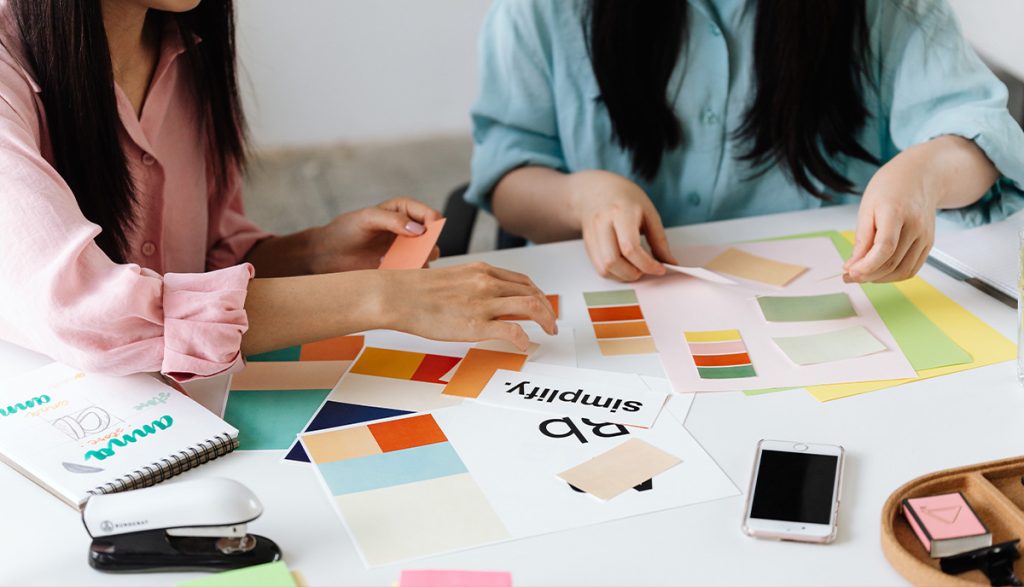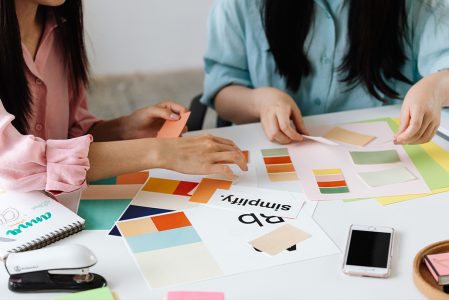When you’re designing a brochure for your business, you’ll need to choose the optimum paper for printing. Let’s walk you through the options and help you to make the best choice for your needs

What paper should I use for Brochures?
Whatever your business — and no matter what the core purpose or target audience of your business brochure is — choosing the right paper for the project is an important question. Which paper you use for your brochures has an impact on design, weight, overall quality of the finished product and the most significant aspect: the customer’s experience.
A poor paper choice can make your brochure look “cheap” and the wrong kind of coating can lead to the images coming out fuzzy or the text harder to read. You also need to consider the brochure style and the paper thickness. So, a paper that’s too heavy might make a saddle stitched booklet-style brochure too thick while a paper that’s not heavy enough could make a single-page tri-fold brochure too flimsy.
At QinPrinting we’re experts in brochure printing and will be happy to advise you about the best choices based on your business, your needs, and your budget. But to give you an overview of what’s involved in how to choose the right paper for a brochure, you can break the problem down into four factors to consider:
Getting the decision right in all of these four areas will result in the perfect paper choice. It’s worth thinking about paper right at the start, before you begin to design and create the content for your brochure. The paper choice will impact other factors including printing techniques, color reproduction, clarity, durability, and how your business brand is presented to the buying public. So, whether your business is an new enterprise just building its brand, an established company reaching out to brand-loyal customers and subscribers, a non-profit distributing important information in a clear and entertaining style, a church group, a local store advertising a new product line or special offer, or anything else: choosing the best paper for your purpose is a decision that will make all the difference to the success of your promotional campaign. Let’s look at the four factors one at a time.
Paper weight for brochures
In the printing world we measure the thickness and stiffness of paper by weight. In most of the world, the units are grams-per-meter (gsm) but in the US we use pounds (lb). We’ll give you the weights in both systems so just pick the one with which you’re most familiar.
In general, most brochures work best when printed on paper no lighter than 70 lb (105 gsm) and no heavier than 100 lb (150 gsm). Both text paper and cover paper are good for brochures at these weights and the choice depends on the details of your project and your budget. Let’s look at your options within this range to help you decide which is best suited to your needs.
70 lb text paper
This is the least expensive choice. It’s a fairly thin paper stock similar to the kind of paper you’ll find used for a paperback novel interior. It takes printed text well and it’s easy to fold. However, it’s not very durable, and photographs and color graphics may look a bit dull when printed on 70 lb stock.
80 lb text paper
Just a touch heavier than the previous option, this is a paper weight that still folds easily but stands better in a rack and will last longer.
100 lb text paper
100 lb text paper is a bit more costly than the other options but still inexpensive compared with the sense of higher quality and texture that it communicates both to look at and to feel in the hand. It’s robust and gives a better, clearer print result.
80 lb cover paper
Cover paper is like a thin card stock, so it’s strong and enduring. It doesn’t fold so well, so a single gate fold rather than a more complex multi-fold may be the best option. But if you want a brochure that can stand up on display on the trade stand, for example, or that will still look good after it’s passed through several hands and bags, this could be a good option for you.
100 lb cover paper
Any thicker than this and you’re moving into card territory, so we’d recommend this as the highest weight for a business brochure. But if you need a real luxury appearance to your product, a brochure that speaks of reliability, class, and style, this could be a great choice.
Paper finishes for brochures
Whatever the weight of the paper you choose, the finish has a vital role to play. Three possibilities — gloss, silk, and matte — all offer specific effects and results. Let’s look at each now.
Gloss paper finish
Gloss coating gives the paper a shiny, reflective finish. It also protects and preserves the paper and the quality of the print for a longer time. If you have a brochure design that includes a large number of photos and color graphics or where these images need to really “pop” with crystal clarity and warm, vibrant color reproduction, then gloss is a good choice.
Silk paper finish
Silk still has a sheen to the surface but it isn’t as glassy and bright as gloss. It keeps color and images bright and crisp but takes away some of the glare that gloss can create under strong light. So, if you have significant text, it will be easier to read with a silk finish without compromising too much on the quality of your images.
Matte paper finish
Matte paper has an almost uncoated appearance. If the text content of your brochure is more important than the images, or if your brochure is all text and doesn’t have any photographs at all, then matte is the best choice. The coating is invisible so there’s no glare or reflection from the paper surface, making lots of text still easy on the eye. But it is coated and so it does protect the paper and the ink, keeping the printed text crisp and fresh.
Color paper for brochures
While most brochures are printed on white, cream, or off-white paper stock, there’s no reason why you shouldn’t choose colored paper. If it’s in keeping with your brand and works well with your overall design, brightly colored paper could make your brochure stand out from the crowd or help you target the right customers. For example, black or velvet blue over-printed with gold lettering speaks of luxury, rainbow colors could appeal to kids, and an earthy, natural green or brown color could be right for you if you’re promoting eco-friendly products and services.
Best paper sizes for brochure printing
The most popular and useful paper sizes for brochures are 8.5 inches by 11 inches, 8.5 inches by 14 inches, and 11 inches by 17 inches. You can experiment with diverse sizes, but these look good, fold well, and fit easily into brochure racks, stack cleanly on stands, and can fit in briefcases, handbags, and so on.
- Brochures printed on 8.5″ x 11″ paper are about the size of a standard letter, fold well into a tower shape and fit snugly into brochure racks and display stands
- Brochures printed on 8.5″ x 14″ give a bit more room for extra content but can still be mailed out or easily displayed in standard racks.
- Brochures printed on 11″ x 17″ won’t fit in racks but are more impressive for trade fairs and other corporate events.
What is the best paper to print brochures on?
As you can see, there’s a lot to think about when choosing the best paper on which to print your brochures. As a general rule of thumb, for a standard promotional or marketing brochure which has a balance of text content and photos or color graphics, 8.5 inches by 11 inches size 100 lb text stock with a silk finish is a safe bet. But the devil is always in the details and each project has its own specific needs.
The best thing to do is get in touch. Tell us about your brochure idea, who your target audience is, and how you’ll be displaying and distributing your brochures and we’ll be happy to give you our best advice, based on over 25 years of success in the industry. We’re an expert team with a real passion for print and a genuine commitment to treating each customer as an individual. Talk to us!

